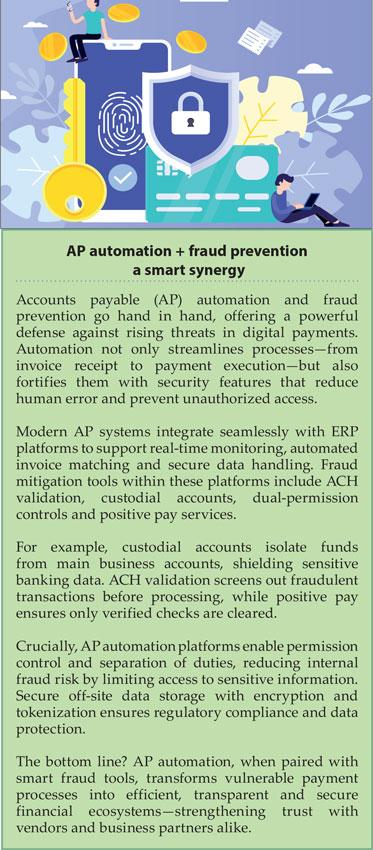The Green Sheet Online Edition
June 23, 2025 • 25:06:02
From vulnerable to vigilant: AP automation in action

In today's rapidly evolving financial landscape, the shift towards digital payments offers numerous benefits to organizations and their vendors and suppliers. Digital payments streamline transactions, enhance convenience and improve efficiency, making them an attractive option for modern commerce.
However, an increase in fraudulent activity has compelled organizations to adopt smarter strategies for fraud prevention by integrating modern payment protection technologies.
Organizations often lack the resources, expertise and bandwidth to appropriately recognize sophisticated illegitimate invoices and prevent fraudulent or incorrect payments, further highlighting the need for robust fraud prevention measures.
As organizations continue to navigate these challenges, the adoption of advanced payment technologies and fraud detection tools becomes essential for safeguarding their operations and maintaining trust with stakeholders and critical business partners.
The growing threat of fraud in digital payments
The number of fraud attacks on the average vendor has risen significantly, with various types of fraud increasing from last year's numbers. Globally, 30 to 40 percent of organizations identify gaps in fraud tool capabilities leading to a rise in phishing attacks, phone scams, invoice fraud, and account takeovers (see bit.ly/4l8shRR).
The lack of internal fraud management resources and limited data access are significantly impacting organizations' abilities to combat deception. Fraud not only impacts sales and revenue rates but also damages relationships with their suppliers. To combat these challenges, and ensure trust, organizations must adopt more sophisticated fraud prevention tools and strategies.
AP payment technology and mitigating fraud risks
Accounts payable automation technology streamlines AP processes, from invoice receipt to payment completion. Payment automation seamlessly integrates with existing enterprise resource planning systems, enhancing efficiency through automated invoice matching and approval processes, real-time monitoring and alerts for suspicious activities, and robust data encryption within secure payment gateways.
This integration ensures more accurate data synchronization, reduces manual errors and accelerates payment cycles. Given that vendors handle both their own and their suppliers' sensitive financial information, AP payment automation technology is necessary to create a secure environment for that data storage and establish an audit trail, reducing the likelihood of unauthorized transactions.
Tools to combat fraud
Payment automation technology incorporates multiple tools and processes to prevent fraud including custodial accounts, ACH validation, permission control and separation of duties, positive pay, and secure data storage.
One effective approach is the use of custodial accounts. Traditional methods like sending paper checks or ACH payments expose bank account numbers to potential fraud. By setting up custodial accounts, organizations can isolate funds in a separate account, preventing fraudsters from accessing primary business accounts.
Funds are transferred only when payments are due, protecting account and routing numbers, limiting who has access to the funds, and providing enhanced control over credits and debits.
Another crucial tactic is ACH validation. Screenings for account status, payment history, ownership, and consistency of personal identifying information (PII) intercept fraudulent ACH transactions before processing. This helps lower ACH return ratios, speed up responses to unsuccessful payments and gain deeper insights into customers.
Permission control and separation of duties are also essential to avoid assigning sensitive payment information access to a single individual. Secure platforms allow organizations to establish permission hierarchies, enable dual control mechanisms and implement contingency plans.
Additionally, positive pay services can be employed. Banks verify the legitimacy of checks before processing them, preventing fraudulent payments.
Finally, data storage is vital for compliance and regulatory reasons. Secure data storage solutions utilize gateways, tokenization, encryption, firewalls, AVS/CVV, and more to protect every payment. Storing data off your server ensures robust security and compliance. By utilizing fraud tools, greater operational efficiency can become the norm.
Challenges and considerations of AP payment automation
Implementing payment automation presents several challenges, with one of the most significant being the integration of legacy systems (see bit.ly/4lb5k0j). This process can be intricate and time-consuming, especially without the guidance of an expert partner.
Ensuring these systems are compatible with new automation technologies is crucial to minimizing disruptions. Organizations often struggle to achieve seamless compatibility between modern automation solutions and outdated infrastructure.
To overcome these challenges, organizations should adopt best practices such as conducting thorough assessments of their current systems, planning for phased implementation and investing in comprehensive training programs for their staff.
Continuous monitoring and updating of fraud prevention strategies are crucial to stay ahead of evolving threats. Regular audits, real-time monitoring and leveraging advanced analytics can help organizations identify and mitigate potential risks effectively.
Protecting AP payment automation with fraud prevention
The shift toward digital payments and AP payment automation technology offers significant benefits, including enhanced efficiency, cost savings and, most importantly, fraud detection. However, organizations must navigate challenges such as integration complexities with legacy systems and initial implementation costs.
By adopting best practices, engaging an expert partner to guide implementation and continuously updating fraud prevention strategies, organizations can maximize the advantages of payment automation.
Looking ahead, the future of payment automation and fraud mitigation is promising, paving the way for more secure and efficient processes. Organizations must embrace AP payment automation technology to safeguard their digital payment processes, protect their revenues and build stronger relationships with customers and vendors.
Darin Horrocks is the executive vice president of business payments at REPAY, https://repay.com, a company dedicated to guiding businesses through the ever-changing world of payments while providing innovative and trustworthy technology. Contact Darin via LinkedIn at linkedin.com/in/darin-horrocks-9a240b7.
Notice to readers: These are archived articles. Contact information, links and other details may be out of date. We regret any inconvenience.





